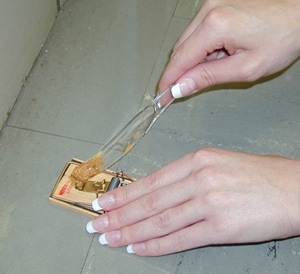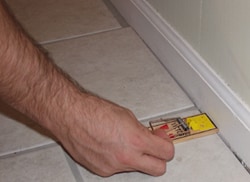How to Trap Up to Remove a Rodent Infestation
Trap rodents around the home to help reduce the rodent population.
If you see evidence of rodents, first check inside and outside your home to see how they got inside. Learn how to seal up holes inside and outside the home to prevent new rodent infestations. Set traps throughout your home to catch any rodents that may still be inside. Continue trapping until there are no more rodents. If no rodents are captured for a week and there are no new signs of rodents, the active infestation has been eliminated.
If evidence of infestation (new droppings (poop), urine spots, gnawing, etc.) persists after one week, you may be dealing with a rat infestation. Rats tend to fear anything new. Pre-baiting traps, or baiting the traps and not setting them, can help rats feel more comfortable with new objects. They will also learn that traps are a non-dangerous food source. Once you notice the bait is being eaten, you can set the traps.

Baiting a snap trap with peanut butter.
How to choose the right trap
Always keep traps and bait out of reach of children and pets. Traditional snap traps are recommended to reduce rodent populations around the home. Only use poison or bait stations for mouse and rat infestations that persist. EPA-registered products are recommended.
DO NOT USE glue traps and live traps. These traps can scare the rodents causing them to urinate, which can increase your chance of getting sick.
Choose the right kind of snap trap for the rodents in your home; there are different traps for mice and rats.
How to set your traps
Carefully read the instructions on the box before setting the trap. When setting the trap, place a small amount of bait (chunky peanut butter or mutton fat works best) on the bait pan of the snap trap. Place the trap on the floor against the wall. Put the baited end of the trap next to the wall so it forms a “T” with the wall. Rodents prefer to run next to walls or other objects for safety and do not like being out in the open.
Place traps in areas where you have seen mice or rats, nesting materials, urine and droppings, nibbled food, or gnaw marks. Place traps in closed areas, such as behind the stove and refrigerator, and in the back of cabinets and drawers. Put traps near other areas where you think rodents are coming into your home, such as attics, basements, crawlspaces, and other areas without regular human traffic. Also place traps in outbuildings and in areas that might likely serve as rodent shelters. Make sure baits are out of reach from children and pets.

Positioning a snap trap so it forms a "T" with the wall.
Check traps daily and immediately dispose of any dead rodents. Some rodents, particularly rats, are very cautious and several days may pass before they approach the traps. Pre-baiting traps to get rats used to the new traps in their environment can help. Other rodents, such as house mice and deer mice, are less cautious and may be trapped more quickly. Reset traps until rodent activity has stopped.
Check bait every week and re-fill or move it as needed for at least 15 days. Leave the baited traps out longer if you still have mice and rats. If trapping does not resolve the infestation, you could consider using a poison bait station or seek professional help. Remember that poison baits can be dangerous for people and animals and must be used according to label instructions.
